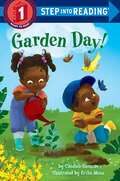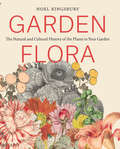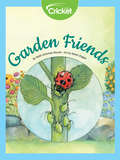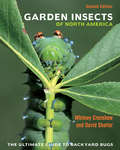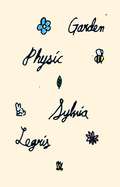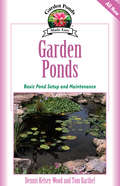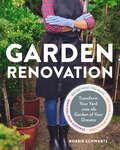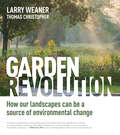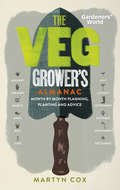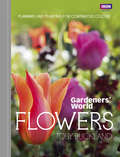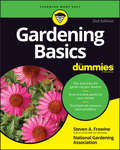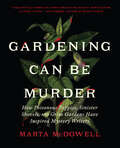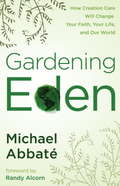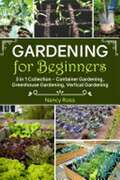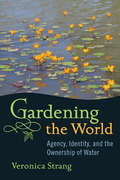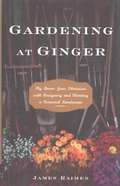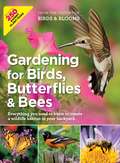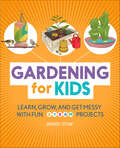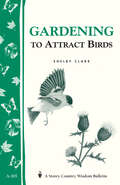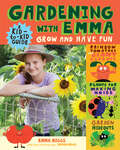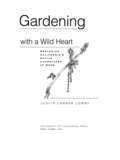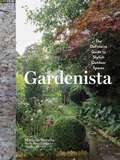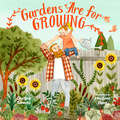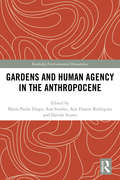- Table View
- List View
Garden Day! (Step into Reading)
by Candice RansomA welcome-to-spring Step 1 reader featuring the family from Pumpkin Day!, Apple Picking Day!, and Snow Day!It's springtime, and the perfect day to plant a garden! The brother and sister from Pumpkin Day!, Apple Picking Day!, and Snow Day! return and plant peas in their backyard. Read along as they dig holes, water the plants, and build a scarecrow with their parents! Easy-to-follow rhyme ensures a successful reading experience, and bright, fun art enhances the story.Step 1 Readers feature big type and easy words. Rhymes and rhythmic text paired with picture clues help children decode the story. For children who know the alphabet and are eager to begin reading.
Garden Flora: The Natural and Cultural History of the Plants In Your Garden
by Noel Kingsbury“A beautifully illustrated reference book covers the origins, ecology and history of popular garden plants.” —Shelf Awareness The oldest rose fossil was found in Colorado and dates to 35 million years ago. Marigolds, infamous for their ability to self-seed, are named for an Etruscan god who sprang from a ploughed field. And daffodils—an icon of spring—were introduced to Britain by the Romans more than 2,000 years ago. Every garden plant has an origination story, and Garden Flora, by noted garden designer Noel Kingsbury, shares them in a beautifully compelling way. This lushly illustrated survey of 133 of the most commonly grown plants explains where each plant came from and the journey it took into home gardens. Kingsbury tells intriguing tales of the most important plant hunters, breeders, and gardeners throughout history, and explores the unexpected ways plants have been used. Richly illustrated with an eclectic mix of new and historical photos, botanical art, and vintage seed packets and catalogs, Garden Flora is a must-have reference for every gardener and plant lover.
Garden Friends
by Faith HickmanGardens make great habitats for many types of animals. Water, protection and food are the benefits for animals living in a garden, and in return they keep the soil healthy, eat pesky insects, and help pollinate the flowers. Ladybugs are helpful to a garden–they eat insects called aphids. Find out which animals are a gardener’s best friends and which are enemies!
Garden Insects of North America: The Ultimate Guide to Backyard Bugs
by Whitney Cranshaw David ShetlarThis second edition of Garden Insects of North America solidifies its place as the most comprehensive guide to the common insects, mites, and other “bugs” found in the backyards and gardens of the United States and Canada. Featuring 3,300 full-color photos and concise, detailed text, this fully revised book covers the hundreds of species of insects and mites associated with fruits and vegetables, shade trees and shrubs, flowers and ornamental plants, and turfgrass—from aphids and bumble bees to leafhoppers and mealybugs to woollybears and yellowjacket wasps—and much more. This new edition also provides a greatly expanded treatment of common pollinators and flower visitors, the natural enemies of garden pests, and the earthworms, insects, and other arthropods that help with decomposing plant matter in the garden.Designed to help you easily identify what you find in the garden, the book is organized by where insects are most likely to be seen—on leaves, shoots, flowers, roots, or soil. Photos are included throughout the book, next to detailed descriptions of the insects and their associated plants.An indispensable guide to the natural microcosm in our backyards, Garden Insects of North America continues to be the definitive resource for amateur gardeners, insect lovers, and professional entomologists.Revised and expanded edition covers most of the insects, mites, and other “bugs” one may find in yards or gardens in the United States and Canada—all in one handy volumeFeatures more than 3,300 full-color photos, more than twice the illustrations of the first edition Concise, informative text organized to help you easily identify insects and the plant injuries that they may cause
Garden Physic
by Sylvia LegrisA musical celebration of the garden, from chaff to grass, and all of its lowly weeds, herbs, and creatures Sylvia Legris’s Garden Physic is a paean to the pleasures and delights of one of the world’s most cherished pastimes: Gardening! “At the center of the garden the heart,” she writes, “Red as any rose. Pulsing / balloon vine. Love in a puff.” As if composed out of a botanical glossolalia of her own invention, Legris’s poems map the garden as body and the body as garden—her words at home in the phytological and anatomical—like birds in a nest. From an imagined love-letter exchange on plants between garden designer Vita Sackville-West and Harold Nicolson to a painting by Agnes Martin to the medicinal discourse of the first-century Greek pharmacologist Pedanius Dioscorides, Garden Physic engages with the anaphrodisiacs of language with a compressed vitality reminiscent of Louis Zukofsky’s “80 Flowers.” In muskeg and yard, her study of nature bursts forth with rainworm, whorl of horsetail, and fern radiation—spring beauty in the lines, a healing potion in verse.
Garden Ponds
by Dennis Kelsey-Wood Tom BarthelIn this colorful Garden Ponds Made Easy title, authors Dennis Kelsey-Wood and Tom Barthell have provided an essential guide for first-time pond enthusiasts. The authors outline all of the considerations for starting out with a new pond, including determining the site, style, size of the pond, and deciding on the construction of the pond (whether preformed, concrete, or fiberglass). Garden Ponds offers a chapter on water which discusses water chemistry factors, volume of the pond, and pond surface. Other important factors involve the aeration, filtration, drainage, and maintenance of a clean (algae-free) pond. Special features, including waterfalls, fountains, and watercourses, electricity, and landscaping are addressed in detail, all accompanied by color photographs and drawings. A chapter on pond construction details every step of the project from creating a blueprint to securing the foundation. The infinite choices involved with stocking the pond with fish and plants can be overwhelming for the first-time pond owner, and the authors give excellent advice about making smart choices for a harmonious, beautiful garden pond. A special chapter on seasonal pond care gives the pond keeper recommendations for maintaining the pond all year long. Resources and glossary included.
Garden Renovation: Transform Your Yard Into the Garden of Your Dreams
by Bobbie SchwartzA do-it-yourself guide to a complete garden rehab Gardens, just like houses, sometimes need makeovers. The changes can be as minor as replacing a shrub or as major as pulling everything up and starting from scratch. No matter the size of your space or the scope of the project, the sage advice in Garden Renovation will help you turn a problem-filled yard into a paradise. Bobbie Schwartz draws on her years of experience as a garden designer to teach gardeners how to evaluate their yards, determine what to keep and what to remove, choose the right plants and design plans for successful remodels, and know when to hire help. A gallery of before-and-after photos provides ideas and inspiration for turning a tired garden into an enlivening retreat.
Garden Revolution: How Our Landscapes Can Be a Source of Environmental Change
by Thomas Christopher Larry WeanerAHS Book Award winner This lushly-photographed reference is an important moment in horticulture that will be embraced by anyone looking for a better, smarter way to garden. Larry Weaner is an icon in the world of ecological landscape design, and now his revolutionary approach is available to all gardeners. Garden Revolution shows how an ecological approach to planting can lead to beautiful gardens that buck much of conventional gardening’s counter-productive, time-consuming practices. Instead of picking the wrong plant and then constantly tilling, weeding, irrigating, and fertilizing, Weaner advocates for choosing plants that are adapted to the soil and climate of a specific site and letting them naturally evolve over time. Allowing the plants to find their own niches, to spread their seed around until they find the microclimate and spot that suits them best, creates a landscape that is vibrant, dynamic, and gorgeous year after year.
Gardeners' World: Month by Month Planning, Planting and Advice
by Martyn CoxGrowing vegetables can be a tricky business, and even the most experienced of gardeners will occasionally need to turn to a trusted tome for some handy advice. The Veg Grower’s Almanac is just such a book – a compendium of month-by-month tips, advice and items of interest. With sage advice from old Gardeners’ World hands coupled with tips on the best varieties to grow and timely advice on how best to look after your plot, this attractive collection blends practical advice with evocative writing and fascinating facts. Illustrated throughout with charming drawings and sketches, The Veg Grower’s Almanac is a welcome additional to any gardener’s shelf – from hands-on instructions for preparing a seed bed or trying new varieties of tomato to fascinating little-known facts about our favourite crops.
Gardeners' World: Planning and Planting for Continuous Colour
by Toby BucklandOver two years the professionals at Gardeners' World created a series of beautiful flower gardens from a disused playing field in Birmingham. Here Toby Buckland reveals how you can adopt the tried and tested methods used at Gardeners' World to create your own year-round flower garden in this beautifully illustrated guide to the flower gardens at Greenacre.Split into achievable front and back garden plots, the Greenacre gardens accommodate a range of garden designs, aspects and plant-types, from a luscious twilight garden for evening scent and nectar-filled bee border to attract beneficial wildlife, to a hardy coastal garden to show what you can do with very dry soil. Toby talks through the concept, planting and maintenance requirements of each garden, describing every flower in full and assessing the environmental benefits of each one. And he expertly demonstrates how to make bespoke garden features, such as cobble paths and bee boxes.Filled with stunning flower photography and expert garden advice, this inspirational and practical book is the culmination of two years of gardening at Greenacre and enables lovers of flowers to bring a little of the Gardeners' World magic to their own gardens.
Gardening Basics For Dummies
by National Gardening Association Steven A. FrowineCultivate your passion to grow In a 1625 essay, Francis Bacon called gardens "the purest of human pleasures," and what was true then is even more so today—gardening can give you a serene refuge from the short-lived (and noisy!) distractions of modern life and a fertile basis for satisfaction that will bear fruit long into the future. To help you get started on your own leafy paradise, the new edition of Gardening Basics For Dummies grounds you thoroughly in the fundamentals of soil, flowers, trees, and lawns—and helps you get to know the names of what you're planting along the way! In a friendly, straightforward style, professional horticulturist Steven A. Frowine distills 50 years of gardening experience to show you how to start growing your expertise—from planning out your own mini-Eden and planting your first annuals, bulbs, and perennials through to laying the perfect lawn, raising tasty crops, and even introducing fish to your landscape! He also digs into the grubbier side of horticultural life, making sure you're as prepared as any seasoned farmer to deal with pests, weeds, and other challenges the earth will throw up at you. Create your ideal garden plan Become an expert on common flora with definitions and descriptions Know how to look after your soil Get creative with butterfly and children's gardens Whether you're beginning with a tiny garden in a box, or beautifying your property with tree-lined groves and flowery bowers, this is the ideal introduction to the intense pleasure of gardening and will make you happy to reap what you’ve sown!
Gardening Can Be Murder: How Poisonous Poppies, Sinister Shovels, and Grim Gardens Have Inspired Mystery Writers
by Marta McDowellThis fun, engrossing book takes a look at the surprising influence that gardens and gardening have had on mystery novels and their authors. With their deadly plants, razor-sharp shears, shady corners, and ready-made burial sites, gardens make an ideal scene for the perfect murder. But the outsize influence that gardens and gardening have had on the mystery genre has been underappreciated. Now, Marta McDowell, a writer and gardener with a near-encyclopedic knowledge of the genre, illuminates the many ways in which our greatest mystery writers, from Edgar Allen Poe to authors on today&’s bestseller lists, have found inspiration in the sinister side of gardens. From the cozy to the hardboiled, the literary to the pulp, and the classic to the contemporary, Gardening Can Be Murder is the first book to explore the mystery genre&’s many surprising horticultural connections. Meet plant-obsessed detectives and spooky groundskeeper suspects, witness toxic teas served in foul play, and tour the gardens—both real and imagined—that have been the settings for fiction&’s ghastliest misdeeds. A New York Times bestselling author herself, McDowell also introduces us to some of today&’s top writers who consider gardening integral to their craft, assuring that horticultural themes will remain a staple of the genre for countless twisting plots to come. &“This book is dangerous. A veritable cornucopia of crime fiction and gardening lore, it faces the reader with multiple temptations—books to seek out, plants to obtain, garden tours to book.&” —Vicki Lane, author of the Elizabeth Goodweather Appalachian Mysteries
Gardening Eden: How Creation Care Will Change Your Faith, Your Life, and Our World
by Michael AbbateBefore the snake,the apple,and the Ten Commandments,God created a garden..."Spiritual environmentalism" did not start out as an oxymoron-it was an invitation. Yet today, many believe God's first job description for humankind has been replaced by other "worthier pursuits". Why has this simple instruction become so controversial? How does one sort through all the mixed messages? Is changing our lives to save the world really our responsibility-or even possible?Gardening Eden invites you to consider a new, spiritual perspective to practical environmentalism. The question is not whether our souls find expression and inspiration in our incredible planet, but how best to preserve that fundamental connection. Green living is no longer a fad-simple lifestyle solutions are now available to everyone. Discover creation care as an act of worship and a call to deeper harmony with our Creator, our fellow gardeners, and our living Earth. Gardening Eden is the primer in how this shift will transform not only our world, but your very soul.From the Trade Paperback edition.
Gardening For Beginners: 3 In 1 Collection - Container Gardening, Greenhouse Gardening, Vertical Gardening
by Nancy RossGardening for Beginners: 3 in 1 Collection - Container Gardening, Greenhouse Gardening, Vertical Gardening
Gardening The World
by Veronica StrangAround the world, intensifying development and human demands for fresh water are placing unsustainable pressures on finite resources. Countries are waging war over transboundary rivers, and rural and urban communities are increasingly divided as irrigation demands compete with domestic desires. Marginal groups are losing access to water as powerful elites protect their own interests, and entire ecosystems are being severely degraded. These problems are particularly evident in Australia, with its industrialised economy and arid climate. Yet there have been relatively few attempts to examine the social and cultural complexities that underlie people's engagements with water. Based on long-term ethnographic fieldwork in two major Australian river catchments (the Mitchell River in Cape York, and the Brisbane River in southeast Queensland), this book examines their major water using and managing groups: indigenous communities, farmers, industries, recreational and domestic water users, and environmental organisations. It explores the issues that shape their different beliefs, values and practices in relation to water, and considers the specifically cultural or sub-cultural meanings that they encode in their material surroundings. Through an analysis of each group's diverse efforts to 'garden the world', it provides insights into the complexities of human-environmental relationships.
Gardening Without Irrigation: or Without Much, Anyway
by Steve SolomonHighly informative book on gardening in arid areas.
Gardening at Ginger
by James RaimesSeven years ago, James Raimes and his wife bought a country home on nine acres in upstate New York. In the tradition of their family, who once owned a cottage named Fred, this larger property became "Ginger." Inspired by the natural beauty of the land and a desire to learn how to be a gardener, Raimes found himself obsessed with such questions as why gardeners keep moving plants around, what the names of the lawn grasses are, and how one can impose order in a garden and at the same time make it look natural. What, in fact, defines a garden?Gardening at Ginger is full of successes and failures, aches and pains, frustrations and delights. But more than that, it's the story of a great discovery: as we try to shape a landscape to reflect who we are, we find that who we are has been reshaped in the process.
Gardening for Birds, Butterflies, and Bees
by Editors at Birds Blooms MagazineWhether you’re installing a new garden bed or trying to attract orioles for the first time, it helps to start with the right information. And here it is! In this book, experts and readers from North America's #1 Bird and Garden Magazine, Birds & Blooms, give their tried-and-true advice.Attracting birds and butterflies has never been simpler—plus you’ll get the latest tips and advice for supporting the dwindling bee population, which experts say is essential for the future of gardening. Inside this book, you’ll find irresistible plants for birds, butterflies, and bees, creative garden designs for year-round beauty, and our top plant lists to take the guesswork out of gardening. No matter what the subject, everyone wants advice they can trust. This is certainly the case when it comes to the backyard. Whether you’re installing a new garden bed or trying to attract orioles for the first time, it helps to start with the right information. And here it is! Birds, butterflies and bees rely on plants, trees and shrubs to survive and thrive. That’s why doing your part for the environment by establishing critter-friendly areas in your own backyard is so crucial. Chances are, your garden is already a welcoming space for all kinds of nature, but with a little extra research and planning, you can take your gardening a couple steps further and transform your yard into a healthier and happier sanctuary for birds, butterflies and bees. This book, brought to you by the editors of Birds & Blooms magazine, can serve as your guide to attracting new visitors to your landscape. Birds & Blooms has helped lead the trend we like to call “gardening with a purpose” for over 20 years. We’ve always recognized the importance of going beyond just the beauty of a garden, and purposefully choosing flowers, trees and shrubs specifically for their environmental benefits. Birds count on healthy trees and plants as natural food sources and nesting sites. Butterflies need nectar-rich blooms for nourishment. Very specific host plants are key to caterpillar survival. And as bee populations decline, flowers that provide nectar and pollen are more essential than ever. Each of these creatures requires natural shelter as well, which trees and shrubs readily provide. If you’re ready to commit to sharing your garden with all sorts of nature, sit down with this book and let us help you create a successful space. All of the 250+ featured plants are not only gorgeous and colorful, but they offer a lot of environmental benefits, too. We made sure to include amazing photos of every plant we’re recommending, so you’ll be able to see what each plant looks like and immediately know if it’s a good fit for your garden. We even went a step further and put together some handy symbols to help you achieve the wildlife-friendly backyard of your dreams. Look for the symbols next to each plant profile to discover what the plant will attract. (Some plants are a triple whammy and attract birds, butterflies and bees!) For extra guidance, check the light-requirement symbols. You’ll be able to quickly see if a plant should be grown in shade, part-shade or full sun—vital info you need to know to create a great habitat. Once you’ve established a flourishing backyard, be sure to enjoy your new guests. Throughout this book, we’ve highlighted about 70 bird species and 35 butterfly species you might see in your space. Have fun identifying all of the birds, butterflies and bees in your own backyard!
Gardening for Kids: Learn, Grow, and Get Messy with Fun STEAM Projects
by Brandy StoneSharpen STEAM skills—and have a blast—with educational gardening projects for kids 8 to 12Discover how fun and educational growing plants can be. Gardening for Kids is packed with essential information for beginner gardeners and tons of awesome projects that help kids grow their science, technology, engineering, art, and math (STEAM) skills.Go outside with easy-to-try experiments that will teach you all about the environment, plants, and what it takes to grow and maintain your very own garden. Find out what your soil is made of, make a miniature greenhouse, race seeds, and so much more!Gardening for Kids provides:Gardening 101—Learn everything you need to get your garden started today, from basic safety tips to helpful advice on caring for your plants.25 Gardening projects—Dig into the natural world with a ton of fun experiments like sprouting food scraps, building plant forts, and more—each one focusing on specific STEAM skills.A chance to grow together—This book features handy tips for expanding projects to work with groups of kids so you can share the fun in classrooms and community gardens.Grow a love of science, technology, engineering, art, and math—plus lots of plants—with Gardening for Kids.
Gardening to Attract Birds: Storey's Country Wisdom Bulletin A-205 (Storey Country Wisdom Bulletin Ser.)
by Shelby ClarkSince 1973, Storey's Country Wisdom Bulletins have offered practical, hands-on instructions designed to help readers master dozens of country living skills quickly and easily. There are now more than 170 titles in this series, and their remarkable popularity reflects the common desire of country and city dwellers alike to cultivate personal independence in everyday life.
Gardening with Emma: Grow and Have Fun: A Kid-to-Kid Guide
by Emma Biggs Steven BiggsThirteen-year-old Emma Biggs is passionate about gardening and eager to share her passion with other kids!Gardening with Emma is a kid-to-kid guide to growing healthy food and raising the coolest, most awesome plants while making sure there’s plenty of fun. With plants that tickle and make noise, tips for how to grow a flower stand garden, and suggestions for veggies from tiny to colossal, Emma offers a range of original, practical, and entertaining advice and inspiration. She provides lots of useful know-how about soil, sowing, and caring for a garden throughout the seasons, along with ways to make play spaces among the plants. Lively photography and Emma’s own writing (with some help from her gardening dad, Steve) capture the authentic creativity of a kid who loves to be outdoors, digging in the dirt. This publication conforms to the EPUB Accessibility specification at WCAG 2.0 Level AA.
Gardening with a Wild Heart
by Judith Larner LowryJudith Lowry's voice and experiences make a rich matrix for essays that include discussions of wildflower gardening, the ecology of native grasses, wildland seed-collecting, principles of natural design, and plant/animal interactions. This lyrical and articulate mix of the practical and the poetic combines personal story, wildland ecology, restoration gardening practices, and native plant horticulture.
Gardenista: The Definitive Guide to Stylish Outdoor Spaces (Remodelista)
by Michelle SlatallaNamed a Best Gift Book for Gardeners by The New York Times Book Review, Los Angeles Times, San Francisco Chronicle, Seattle Times, Domino magazine, and Goop. The team behind the inspirational design sites Gardenista.com and Remodelista.com presents an all-in-one manual for making your outdoor space as welcoming as your living room. Tour personality-filled gardens around the world and re-create the looks with no-fail planting palettes. Find hundreds of design tips and easy DIYs, editors&’ picks of 100 classic (and stylish) objects, a landscaping primer with tips from pros, over 200 resources, and so much more.
Gardens Are for Growing
by Chelsea TornettoA wonderful book for garden lovers and growing families.
Gardens and Human Agency in the Anthropocene (Routledge Environmental Humanities)
by Ana Simões Maria Paula Diogo Ana Duarte Rodrigues Davide ScarsoThis volume discusses gardens as designed landscapes of mediation between nature and culture, embodying different levels of human control over wilderness, defining specific rules for this confrontation and staging different forms of human dominance. The contributing authors focus on ways of rethinking the garden and its role in contemporary society, using it as a crossover platform between nature, science and technology. Drawing upon their diverse fields of research, including History of Science and Technology, Environmental Studies, Gardens and Landscape Studies, Urban Studies, and Visual and Artistic Studies, the authors unveil various entanglements woven in the past between nature and culture, and probe the potential of alternative epistemologies to escape the predicament of fatalistic dystopias that often revolve around the Anthropocene debate. This book will be of great interest to those studying environmental and landscape history, the history of science and technology, historical geography, and the environmental humanities.
